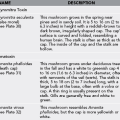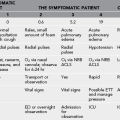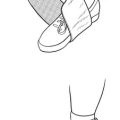Diabetic Emergencies
Disorders
Signs and Symptoms
1. Altered level of consciousness, such as confusion, behavioral changes, nervousness, belligerence, syncope, seizures, unconsciousness, or coma
2. Weakness, tremor, diaphoresis, pallor, abdominal pain, ataxia, slurred speech, tachycardia
3. Minimal to absent prodrome; patient may become unarousable without warning
Treatment
1. If possible, obtain a blood glucose reading before initiating therapy.
2. If the patient is still conscious and able to swallow without choking, give the person something containing sugar to drink or eat as soon as possible. This could be sugar, fruit juice, a banana, candy, or a nondiet soft drink. As soon as the patient feels better, have him or her eat a meal to avoid a recurrence.
3. If the patient is unconscious:
a. Place tiny amounts of sugar granules, cake icing, oral glucose gel (one tube of Glutose 15 contains 15 g glucose), or other sugar source under the patient’s tongue, where it can be passively swallowed and absorbed.
b. If intravenous access can be established, administer 1 to 2 ampules of dextrose (25 g of 50% glucose [dextrose] in each ampule) while attending to the circulation, airway, and breathing (CAB) approach to resuscitation. In a child younger than 8 years of age, administer an initial bolus of dextrose, 0.25 g/kg of body weight. This is usually achieved with 2.5 mL/kg of 10% dextrose solution, because extravasation of higher concentrations of glucose will lead to severe tissue damage. The bolus should be administered slowly (2 to 3 mL/min), regardless of age.
c. As an alternative in a patient for whom you cannot quickly obtain IV access, administer 1 to 2 mg of glucagon for adults and 0.5 mg for children weighing less than 20 kg (44 lb) intramuscularly. Patients usually regain consciousness within 5 to 20 minutes of receiving glucagon, although it may be followed by marked nausea or vomiting. This dose may be repeated after 15 minutes if necessary. Glucagon kits should be checked regularly and replaced when they are beyond the expiration date.
Glucagon Administration Instructions (GlucaGen HypoKit)
• Remove the seal from the bottle of glucagon.
• Remove the needle protector from the syringe, and inject the entire contents into the bottle of glucagon,
• Swirl bottle gently until glucagon dissolves completely.
• Using the same syringe, hold bottle upside down and, making sure the needle tip remains in solution, gently withdraw all of the solution.
• Cleanse injection site on buttock, arm, or thigh with alcohol swab.
• Insert the needle into the muscle under the cleansed injection site, and inject all (or one-half for children weighing less than 20 kg ([44 lb]) of the glucagon solution.
• Remove the needle, and apply light pressure at the injection site.
4. Provide supportive care, including airway management, aspiration and seizure precautions, administration of oxygen, and treatment of shock.
5. The blood glucose level should be checked after 15 to 20 minutes to ensure that the glucose level has increased to a safe level (>100 mg/dL) before continuing with the physical activity. The person should be closely watched for evidence of recurrent symptoms.
Diabetic Ketoacidosis
Signs and Symptoms
1. History of recent polydipsia, polyuria, polyphagia, blurred vision, weakness, weight loss, nausea, vomiting, and abdominal pain
2. Early symptoms: polyuria, polydipsia, nausea and vomiting
3. Later symptoms: tachycardia, tachypnea with Kussmaul respirations (deep, rapid breathing), hyperventilation, and possibly fruity odor (similar to the odor of nail polish remover) on the breath because of exhaled acetone
4. Abdominal pain, especially in children
5. Signs of volume depletion (dry mucous membranes, absence of sweating, decreased skin turgor, orthostatic hypotension)
6. Eventually: confusion, combativeness, or coma with signs of profound dehydration
7. Possibly hyperthermia or hypothermia if sepsis is present
Treatment
1. If unsure whether the patient has hyperglycemia or hypoglycemia, assume it is hypoglycemia and administer glucose.
2. Treatment of DKA in the field is challenging because of the necessity for fluid, electrolyte, and insulin replacement and the need for frequent electrolyte monitoring. If the patient can drink, encourage him or her to consume large quantities of unsweetened fluids. The average fluid loss in DKA is 3 to 6 L.
3. If available, initially administer IV NS solution (2 L over 2 hours in adults and 10 to 20 mL/kg in children). Fluid resuscitation alone may help considerably in lowering hyperglycemia and begin to correct the metabolic abnormalities.
4. Provide supportive care, including airway management, oxygen administration, and shock treatment, while transporting the patient to a medical center.
5. If insulin is available and glucose levels can be closely monitored in the field, consider administering insulin as an IV infusion at a rate of 0.1 unit/kg/hr until the measured glucose level is less than 250 mg/dL (13.9 mmol/L).
6. Subcutaneous insulin therapy may also be used and is most effective with rapid-acting insulin analogs (insulin lispro and aspart) if the patient is not in shock. Administer subcutaneous insulin as an initial injection of 0.3 units/kg followed by 0.1 units/kg every hour until the serum glucose level is less than 250 mg/dL (13.9 mmol/L). During treatment, blood glucose should be measured at least every hour. The subcutaneous administration of insulin lispro and aspart has an onset of action within 10 to 20 minutes and reaches a peak insulin concentration within 30 to 90 minutes. These time intervals are significantly shorter than those observed with subcutaneous regular insulin, which has an onset of action of 1 to 2 hours and reaches a peak effect at 2 to 4 hours.
Hyperglycemic Hyperosmolar State
Treatment
1. The average fluid loss in HHS is 8 to 10 L, largely as a result of the glucose osmotic diuresis. If the patient can drink, encourage him or her to consume large quantities of unsweetened fluids.
2. If intravenous access is available, administer NS solution. In the absence of cardiac compromise, saline is infused at a rate of 10 to 15 mL/kg lean body weight per hour (about 1000 mL/hr in an average-sized person) during the first few hours, with a maximum of 50 mL/kg in the first 4 hours.
3. After an initial infusion of saline to increase insulin responsiveness by lowering the plasma osmolality, consider administering insulin as described earlier for DKA.






